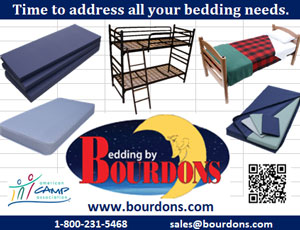For the better part of a decade, I met many of the industry’s facilities leaders and staff in person at the Maintenance Conference in March every year. It was a great reprieve from winter captivity and provided an opportunity to network and acquire new skills and knowledge. George Painter, camp executive director and host of the event, never failed to remind everyone at the first lunch: “Don’t be so busy cutting wood that you don’t stop to sharpen your saw.” True, wise words then and today.
Though the COVID-19 pandemic has really put a crimp in the whole industry, some silver linings to the dark cloud have emerged. Innovative camp program directors figured out ways to keep their campers engaged long distance even when resident and day camps had to be canceled. In much the same way across the engineering and facilities world, distance education opportunities were adapted from in-person to online formats in amazing numbers and with lightning speed. Professional associations, industry groups and affiliations, and even government entities suddenly were able to educate anyone willing to attend.
So, while many critical facility skills are best taught by “doing,” others can be and are well conveyed in the informal classroom of one’s home office or anyplace with an internet connection. Following are just a few of the opportunities available to make you a more valued, more deeply integrated member of the camp staff without ever leaving your home base.
Small Engines
Small engine repair and care is one great example of an industry that has adapted its schooling to include online resources. For example, the Equipment & Engine Training Council (EETC) has developed relationships with literally dozens of small engine manufacturers to provide a broad curriculum across many lines of equipment. This nonprofit’s board includes leaders from MTD, Kawasaki, and Echo, among several others. Furthermore, the budding organization recognized early on that affiliation with higher education would provide access to certification paths, so several prominent members of the EETC Executive Board and Board of Directors are affiliated with technical and state universities. EETC’s website provides access to dozens of professionally produced videos with high-tech animations and explanations supported by cutaway views of real, moving engine components. Even the best “hands on” mechanic can have a hard time explaining clearly what can be shown with a working cutaway model. The explanations are straightforward and clear, beginning with the fundamentals of the topic and working into more complex subjects necessary to master sophisticated concepts like spark, mixture, and engine timing. The EETC also provides online testing and certification programs. Of course, a fee is required to take the exams, but there are also practice tests. It provides an entry-level certification with which all facilities staff — new hires to old hands — can document their knowledge and understanding of small engines. Take some time to look through the site and you’re likely to find that a wealth of information is available to you and your staff for a minimal investment of time and money.
Know the Code
You probably know that the residential building codes don’t apply to camp buildings, but instead commercial building codes do. Design professionals such as architects and engineers are trained to apply the proper code and deliver the special facilities camps need. But construction is just the first step. Understanding how the codes are structured will always help you, the facilities staff, better contribute during the planning, permitting, and design of the next camp improvement. To that end, the source organization of those instructions, the International Code Council, has developed materials that provide camp leadership with that basic understanding. They offer a free, two-part webinar that builds the foundation to understanding why they’re necessary and how they work to keep your staff and guests safe. You might expect it to be heavy-handed, dry, technical droning. Instead, the material is delivered in a light, nontechnical fashion with the aim of truly conveying and building an understanding through engaging case studies. They offer some additional free resources for you to explore specific topics in more detail too. Collectively, these online offerings will leave you better prepared to ask your professional important questions about the construction, operation, and maintenance of any upcoming capital investment.
Hazardous Materials
Camp properties and their facilities are aging. Some buildings are old and have been lovingly maintained by generations of caretakers. But we have discovered over time that certain construction practices from years ago can present health hazards to guests and staff. For example, asbestos and lead — both very dangerous — were used often as durable construction materials as recent as three decades ago. How many camp buildings are 30 years old or more? Do you know how to recognize a potential hazard and what steps to take to deal with it?
The Occupational Safety and Health Administration offers basic identification and response training through which you will learn that asbestos was very common as siding and floor tiles for decades, and that lead oxide was the only pigment for brilliant white paint for even longer. You’ll also likely hear that asbestos is not a hazard unless it’s friable (crumbly, brittle, or flaky) and its fibers become airborne, as might happen when removing tile for a new floor or preparing to reside cabins). The same holds for paint and the dust that’s created when scraping, sanding, and repainting. One other important thing that you will learn is that the owner (the camp) of these materials is responsible for their proper collection, containment, treatment, transport, and disposal, along with any residual contamination (like dust that collects outside the building during the scraping). Even without certification to abate the condition yourself, understanding the history, rules, and financial implications will help you, as a camp facility professional, make sure that hazards and liability/risk are addressed and reduced. Certification courses and certificates can be pursued from private online providers for as little as $20.
These are just a few topics available for your benefit and at little to no cost through distance education. An internet search of almost any facilities topic will return opportunities to learn informally (maybe by reading a manufacturer’s product pages), or more formally through web-based real-time or recorded classes. COVID-19 was disruptive to say the least. But as with so many challenges, ingenuity and innovation stepped in to overcome significant difficulties very quickly. One of the best benefits has been the online educational resources that have sprouted up all over the internet. By providing opportunity and a very modest budget (in the hundreds of dollars per year for even an aggressive effort), camp facilities professionals can truly become the “duty experts” on almost any issue on the horizon.
At the Maintenance Conference, Painter was known to share a number of colorful and fitting phrases in addition to his quip about chopping wood, including, “Work smarter, not harder.” Case in point, in a profession that already presents lots of surprises, why not prepare and get ahead of the game by taking a little time to grow your skillset and knowledge base? You and your camp will both benefit.
Rick Stryker, PE, is a professional engineer who is passionate about camps and the opportunities they provide. He’s always delighted to answer email questions at [email protected].



